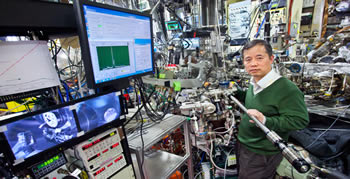Photon Science: X-Rays for Discovery

ALS Beamline 7.0.1 - Northern California site of the Joint Center for Artificial Photosynthesis (JCAP).
Scientists in Berkeley Lab’s Advanced Light Source, Accelerator and Fusion Research Division, and other divisions are exploring new ways to produce ultrafast, ultrabright beams of x-rays that can catch electrons in the act of reshaping the world around us.
Energy from sunlight
Ultrafast x-rays could be used to analyze the chemistry of natural photosynthesis, where light energy is converted to chemical energy so quickly that none is wasted as heat. With this knowledge scientists could create artificial photosynthesis, using sunlight to convert water and carbon dioxide, without waste, into clean liquid fuels and hydrogen for fuel cells. Solar cells could also be vastly improved by learning how to get two electrons for each photon absorbed, instead of just one, the best today’s solar cells can hope for.
Healing the human body
Fast, bright x-rays could help medical scientists watch the machinery of life in motion on nature’s timescale. Ultrafast, high-repetition-rate, coherent x-rays could image the structures of active proteins in motion. Exquisitely detailed movies of molecular machines, cell components, and whole living cells in action could enable advances in toxicology, pharmacology, and our understanding of the human body and how it works, leading to cures for numerous diseases including cancer in its many forms.
Green chemistry
Using x-rays to probe chemical reactions in real time could help usher in an age of energy-saving, waste-free green chemistry. Today’s catalysts synthesize fertilizers from ammonia, make synthetic fuels, and run fuel cells; they even clean up tailpipe emissions. Tomorrow’s smarter catalysts would eliminate more waste, cut more pollution, and use less energy. By identifying the complex and rapid changes involved in catalysis, step-by-step as they occur, researchers could engineer nanoparticle catalysts that instantly adjust to every stage of the chemical process.
Super electricity
With x-rays, scientists can uncover the hidden secrets of magnetism and electronics. Transmission over wires wastes electricity because of resistance, yet electric current passes through a superconductor with no resistance at all. X-rays could help solve the problem of how to transmit electricity with high-temperature superconductivity. And to build new batteries for the electric vehicles of the future, X-rays could light up groups of electrons and track their energy, how they spin, and how they move as the battery charges and discharges.

